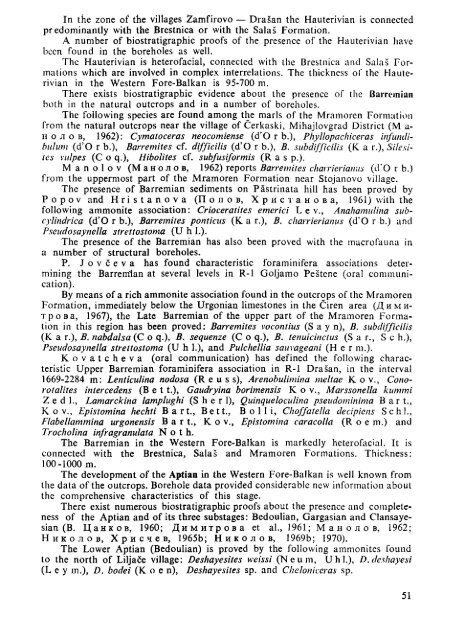THE MEDITERRANEAN LOWER CRETACEOUS
THE MEDITERRANEAN LOWER CRETACEOUS
THE MEDITERRANEAN LOWER CRETACEOUS
Create successful ePaper yourself
Turn your PDF publications into a flip-book with our unique Google optimized e-Paper software.
In the zone of the villages Zamfirovo — DraSan the Hauterivian is connected<br />
predominantly with the Brestnica or with the Salas Formation.<br />
A number of biostratigraphic proofs of the presence of the Hauterivian have<br />
been found in the boreholes as well.<br />
The Hauterivian is heterofacial, connected with the Brestnica and Salas Formations<br />
which are involved in complex interrelations. The thickness of the Hauterivian<br />
in the Western Fore-Balkan is 95-700 m.<br />
There exists biostratigraphic evidence about the presence of the Barremian<br />
both in the natural outcrops and in a number of boreholes.<br />
The following species are found among the marls of the Mramoren Formation<br />
from the natural outcrops near the village of Cerkaski, Mihajlovgrad District (M aполов,<br />
1962): Cymatoceras neocomiense (d'O г b.), Phyllopachiceras infunclibuhim<br />
(d'O r b.), Barremites cf. difficilis (d'O r b.), B. subdifficilis (К а г.), Silesitcs<br />
vulpes (С о q.), Hibolites cf. subfusiformis (Ras p.).<br />
Manolov (Манолов, 1962) reports Barremites charrieriamis (d'O r b.)<br />
from the uppermost part of the Mramoren Formation near Stojanovo village.<br />
The presence of Barremian sediments on Pâstrinata hill has been proved by<br />
Popov and Hristanova (Попов, Христанова, 1961) with the<br />
following ammonite association: Crioceratites emerici Lev., Anahamulina subcylindrica<br />
(d'O г b.), Barremites ponticus (К. а г.), В. charrierianus (d'O r b.) and<br />
Pseudosaynella strettostoma (U h I.).<br />
The presence of the Barremian has also been proved with the macrofauna in<br />
a number of structural boreholes.<br />
P. Jovceva has found characteristic foraminifera associations determining<br />
the Barremian at several levels in R-l Goljamo Pestene (oral communication).<br />
By means of a rich ammonite association found in the outcrops of the Mramoren<br />
Formation, immediately below the Urgonian limestones in the Ciren area (Д и м итрова,<br />
1967), the Late Barremian of the upper part of the Mramoren Formation<br />
in this region has been proved: Barremites vocontius (Say n), B. subdifficilis<br />
(К а г.), В. nabdalsa (С о q.), В. sequenze (С о q.), В. tenuicinctus (S а г., S с h.),<br />
Pseudosaynella strettostoma (U h 1.), and Pulchellia sauvageani (Her m.).<br />
Kovatcheva (oral communication) has defined the following characteristic<br />
Upper Barremian foraminifera association in R-l Drasan, in the interval<br />
1669-2284 m: Lenticulina nodosa (Reus s), Arenobulimina meltae К о v., Conorotalites<br />
inter cedens (Bet t.), Gaudryina borimensis К о v., Marssonella kummi<br />
Z e d 1., Lamarckina lamplughi (S h e г 1), Quinqueloculina pseudominima Bart.,<br />
К о v., Epistomina hechti Bart., В et t., В о 11 i, Choffatella decipiens Schl.,<br />
Flabellammina urgonensis В a г t., Ko v., Epistomina caracolla (Roe m.) and<br />
Trocholina infragranulata N о t h.<br />
The Barremian in the Western Fore-Balkan is markedly heterofacial. It is<br />
connected with the Brestnica, Salas and Mramoren Formations. Thickness:<br />
100-1000 m.<br />
The development of the Aptian in the Western Fore-Balkan is well known from<br />
the data of the outcrops. Borehole data provided considerable new information about<br />
the comprehensive characteristics of this stage.<br />
There exist numerous biostratigraphic proofs about the presence and completeness<br />
of the Aptian and of its three substages: Bedoulian, Gargasian and Clansayesian<br />
(B. Цанков, 1960; Димитрова et al., 1961; Манолов, 1962;<br />
Николов, Хрисчев, 1965b; Николов, 1969b; 1970).<br />
The Lower Aptian (Bedoulian) is proved by the following ammonites found<br />
to the north of Liljaôe village: Deshayesites weissi (Ne urn, Uhl.), D. deshayesi<br />
(Ley in.), D. bodei (К о e n), Deshayesites sp. and Cheloniceras sp.<br />
51

















